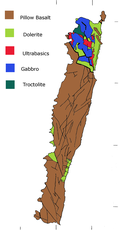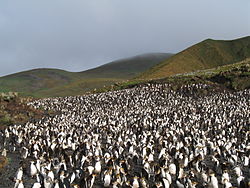Macquarie Island
Macquarie Island is a large island in the Southern Ocean. It is about 1,500 km (932 mi) south east of Tasmania, and about half way between Australia and Antarctica. The island became a UNESCO World Heritage Site in 1992. Macquarie Island is about 34 km (21 mi) long and 5 km (3 mi) wide. It was first discovered in July 1810, by Captain Hasselburgh, who was searching for places to hunt whales and seals. No people live there now. The only way to get to the island is by sea and there are no harbors to dock a ship.
| Sobriquet: Macca | |
|---|---|
| Geography | |
| Location | Southwestern Pacific Ocean |
| Coordinates | 54°30′0″S 158°57′0″E / 54.50000°S 158.95000°E |
| Area | 128 km2 (49 sq mi) |
| Length | 35 km (22 mi) |
| Width | 5 km (3.1 mi) |
| Elevation | 410 m (1,350 ft) |
| Country | |
Australia | |
| Demographics | |
| Population | No permanent inhabitants |
Geology
The island was formed by two tectonic plates meeting and forcing each other upwards. It is the only place on Earth where rocks from the Earth's mantle, 6 km (4 mi) below the ocean floor, are being pushed up above sea level. Confirmation is in this reference under section "Criterion (viii)".[1]
Plants and animals
Many birds and animals use Macquarie Island to breed. About 3.5 million seabirds and 80,000 elephant seals come to the island every year.[2] Four types of penguins live on the island. There are about 850,000 royal penguins, 200,000 king penguins, 10,000 gentoo penguins, and rockhopper penguins with numbers thought to be between 20,000 and 1,000,000.[3]
In 1977 Macquarie Island became a Biosphere Reserve. The coastal ecosystem is recognized as part of UNESCO's Man and the Biosphere (MAB) Programme.[4]
Macquarie Island Media
Simplified geological map
King penguin rookery at Lusitania Bay
Male elephant seal vocalising
Royal penguin rookery at Hurd Point
Macquarie Island flora, Epilobium pedunculare
Macquarie Island flora, Stilbocarpa polaris
Related pages
References
- ↑ "Macquarie Island - UNESCO World Heritage Centre". whc.unesco.org. 2012. Retrieved 22 April 2012.
- ↑ "Macquarie Island World Heritage Area". Parks & Wildlife Service, Tasmania. 2012. Archived from the original on 18 April 2012. Retrieved 22 April 2012.
- ↑ "Macquarie Island - Animals and Plants". Parks & Wildlife Service, Tasmania. 2012. Archived from the original on 21 March 2012. Retrieved 22 April 2012.
- ↑ World Network of Biosphere Reserves (WNBR), "Macquarie Island"; retrieved 2012-7-18.
Other websites
![]() Media related to Macquarie Island at Wikimedia Commons
Media related to Macquarie Island at Wikimedia Commons
- "Macquarie Island - UNESCO World Heritage Centre". whc.unesco.org. 2012. Retrieved 22 April 2012.
- List of biosphere reserves which are wholly or partially world heritage sites
![]()






